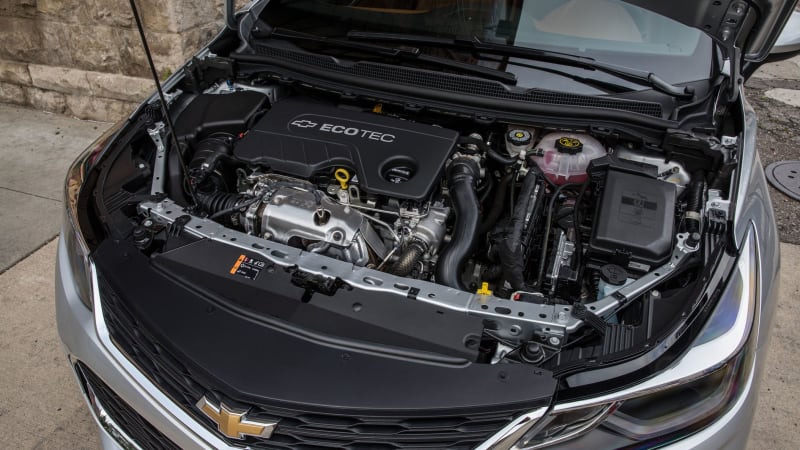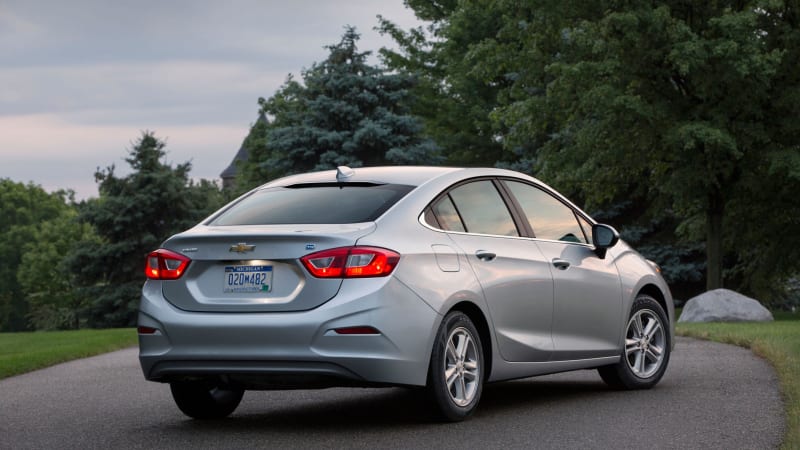Amid the industry-wide shift to larger trucks, SUVs and crossovers, the Chevrolet Cruze represents an increasingly rare breed: an American compact car that’s actually built in the U.S., not imported from overseas. First released in the U.S. in 2008 and built in Lordstown, Ohio, the nameplate goes back to the turn of the millennium in Japan as part of a joint venture with Suzuki. It’s part of a generation of American small cars credited with salvaging their ilk’s once-poor reputation.
The Cruze is offered in a hatchback variant, but we’ll limit this buying guide to the sedan, which is offered in four trim levels: L, LS, LT and Premier. The LT is also available with a diesel engine; more on that later.
If you like driving a stick, the Cruze is one of six Chevrolet models that are offered with a six-speed manual transmission (for now: It’s going away when the 2019 version rolls into showrooms), except on the Premier. Otherwise, you get a six-speed automatic standard, or a nine-speed automatic with the diesel version.

Chevrolet’s RS performance package is available on the LT and Premier nondiesel versions and includes a rear spoiler, front fog lamps, sport body kit and RS ornamentation. If you go the RS route on the LT sedan equipped with an automatic transmission, you can option the Redline Edition, which adds red-outlined black emblems, a black grille bowtie badge, black beltline, grille and fog lamp trim, special 18-inch wheels and a Z-link rear suspension.
This guide will help you make an educated decision about whether to buy the 2018 Chevy Cruze. We’ll touch on safety and reliability ratings, engine specs, horsepower, fuel-economy ratings and pricing, and we’ll conclude with a summary of what the Autoblog editors who’ve reviewed the Cruze think of it.
Chevy Cruze safety ratings
The National Highway Traffic Safety Administration gives the 2018 Chevy Cruze an overall five-star rating, the top rating possible for protecting the driver and passengers against injury. The federal agency gives the Cruze a five-star frontal crash rating and four of five stars for both side-crash and rollover-crash protection.
Crash-test data on the Cruze from the Insurance Institute for Highway Safety is more patchwork in nature. IIHS gave the 2018 Cruze “good” ratings for both moderate overlap front- and side-crash protection and a “marginal” rating for child-seat LATCH anchors, but it apparently didn’t subject the car to many of its tests. When it reviewed the 2016 Cruze Limited, it gave the car a “marginal” rating for driver-side small overlap front-crash protection; “good” ratings for moderate overlap front crashes, side crashes, roof strength and head restraint and seats; and an “acceptable” rating for child seat anchor ease of use.
Ratings may differ for Cruzes from other model years, so be sure to visit the NHTSA and IIHS websites to review ratings on the specific vehicle you’re researching.

Is the Chevy Cruze reliable?
J.D. Power most recently reviewed initial quality of the 2017 Cruze, which is part of the same generation and largely similar to the 2018 model.
It gave the Cruze five out of five possible stars for overall quality, three stars — “about average” — for overall performance and design and four stars — “better than most” — for predicted reliability. Diving deeper, it awarded the Cruze five stars for body and interior design quality, three stars for powertrain quality design and overall mechanical quality and two stars for powertrain mechanical quality.
We should note that Autoblog has voiced some concerns with the way J.D. Power weighs serious and less-serious reliability issues, which you can read about here.
According to NHTSA, there have been five separate recalls of the Cruze issued between 2013 and 2016, mostly to fix minor issues with older-model cars. The most serious was in 2014, when GM recalled 174,046 Cruzes from 2013 and 2014 to fix a half shaft at risk of fracturing and separating, which left the car vulnerable to losing power and coasting to a stop or rolling away if left in Park if the emergency brake wasn’t engaged. During the same year, GM recalled nearly 30,000 model-year 2013 and 2014 Cruzes as part of the Takata airbag scandal to fix the inflators.
How much interior and cargo room does the Chevy Cruze have?
The 2018 Chevy Cruze seats up to five people. It offers 42 inches of legroom up front and 36.1 inches in the rear. There’s 38.9 inches of headroom in the front and 37.3 in the rear. You get 14.8 cubic feet of cargo volume in the L and LS, or 13.9 cubic feet in the LT and Premier.
By way of comparison, the 2018 Honda Civic has 42.3 inches of front legroom, 37.4 inches in the rear and tops out at 39.3 inches of headroom in the front and 37.1 in the rear. Cargo volume in the Civic is 15.1 cubic feet.

Chevy Cruze engine specs and horsepower
All trim levels come with the standard 1.4-liter turbocharged, direct-injected inline-four engine, while a 1.6-liter turbo-diesel engine is available on the LT. The former offers 153 horsepower and 177 pound-feet of torque, while the diesel generates 137 hp and 240 lb-ft of torque.
How fuel efficient is the 2018 Chevy Cruze?
It’s pretty fuel-efficient, actually. Here’s how the EPA rates the standard gasoline combustion-engine versions:
- 1.4-liter six-speed automatic — 29 mpg city, 40 highway, 33 combined
- 1.4-liter six-speed automatic Premier trim — 29 mpg city, 39 highway, 33 combined
- 1.4-liter six-speed manual — 27 mpg city, 40 highway, 32 combined
Diesel versions, which are the most fuel efficient, break down like so:
- Six-speed manual — 30 mpg city, 52 highway, 37 combined
- Nine-speed automatic — 31 mpg city, 47 highway, 37 combined
How much does the Chevy Cruze cost?
The 2018 Chevrolet Cruze starts at $ 17,850 for the L trim and tops out at $ 27,170 for the 1.6-liter diesel nine-speed automatic with LT content. Both prices are inclusive of the $ 875 destination freight charge.
Use Autoblog’s Smart Car Buying program powered by TrueCar to search out competitive local pricing and savings on the 2018 Chevrolet Cruze.

Autoblog Chevy Cruze review
Autobloglast reviewed the 2016 Chevrolet Cruze, when the current generation was first introduced. Contributing editor Brandon Turkus compared it favorably to the 1998 Pontiac Sunfire he drove in high school, concluding that “today’s high schoolers have it good.”
“The Cruze is a compact my classmates and I could have only dreamt of,” he wrote. “My old Sunfire didn’t even have a tape deck or CD player, but the Cruze has a MyLink infotainment system, standard. The (Sunfire’s) J-body’s 115-hp, 2.2-liter engine is no match for the Cruze’s cutting edge, 153-hp, 1.4-liter turbo inline-four. And it doesn’t look like an emasculated Firebird. These kids today just don’t know how lucky they are.”
Related Video:




